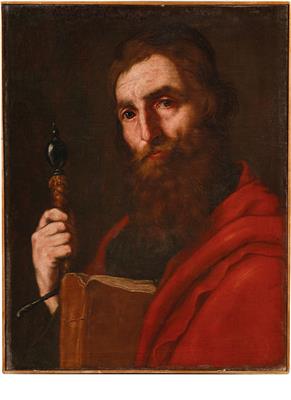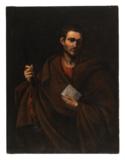Jusepe de Ribera

(Játiva 1591–1652 Naples)
Saint Paul,
monogrammed lower left: JR (ligated) a.,
oil on canvas, 64 x 49.5 cm, framed
A wax seal with a coat-of-arms on the reverse (possibly the Marulli family).
Provenance:
possibly collection of the Duchess of Eboli, Maria Lilla Grimaldi Cebà, Palazzo Doria d’Angri, Naples, 18th Century;
possibly by descent to her daughter Princess Donna Maria Geronima Doria d’Angri, Pietravairano, Caserta, second quarter of the 18th century (inv. no. 16, as de Ribera);
possibly by descent to the collection of the Dukes Marulli di San Cesario;
possibly by descent to the collection of the Dukes Mainenti, Palazzo Mainenti, Vallo della Lucania, Salerno (register “delle opere antiche”, no. “81 già // 16”);
possibly testament of Francesco Mainenti, 1864 (as Spagnoletto);
possibly transferred to the Naples home of the Mainenti family, in the 1920s;
sale, Babuino, Rome, 28 October 2014, lot 80 (as Giovanni Ricca);
sale, ACR Auctions, London, 30 June 2015, lot 11 (as Jusepe de Ribera [workshop]);
European art market;
where acquired by the present owner
We are grateful to Nicola Spinosa for confirming the attribution of the present painting after the examination in the original.
Ribera was influenced by the realism of Caravaggio, however, from the early 1630s he introduced a lighter, more radiant tonal range to his palette, lending his paintings a softer character. The artist was at the height of his career at this time; he had become the leading painter in Naples, a city that enjoyed an esteemed reputation and was the second largest urban centre in Europe, alive with artistic creativity and a coveted destination for painters from the rest of the continent. In addition to the commissions from the local Neapolitan patrons, Ribera provided pictures for a burgeoning market of foreign clients who were drawn to his dramatic, magnetic naturalism executed with startling originality and virtuosity.
The present Saint Paul fits perfectly into this context. Indeed, the saint is depicted as a three-quarter-figure, holding his attribute, the sword, in his right hand and raising up a book with his left hand. The saint’s attention is firmly focused onto the viewer, encouraging us to reflect on his spiritual transformation and trust.
The colour palette is reduced to earthy brown tones, with colour highlights in the flesh tones and the bright red cloak. The skin is modelled by using open brushstrokes and mixing the different colour tones directly on the canvas, thereby creating plasticity and depth. The hair and fingers are modelled with fine lines, giving the impression of a particular graphical quality and providing a counterbalance to the wide brushstrokes elsewhere. Due to the abdication of any harsh outlines, the saint’s body appears to merge into the brownish background. Furthermore, the figure is illuminated from the left by a light source outside the pictorial plane, that helps enhance the interplay between light and shadow.
Esperto: Mark MacDonnell
 Mark MacDonnell
Mark MacDonnell
+43 1 515 60 403
oldmasters@dorotheum.com
10.11.2021 - 16:00
- Prezzo realizzato: **
-
EUR 83.200,-
- Stima:
-
EUR 60.000,- a EUR 80.000,-
Jusepe de Ribera
(Játiva 1591–1652 Naples)
Saint Paul,
monogrammed lower left: JR (ligated) a.,
oil on canvas, 64 x 49.5 cm, framed
A wax seal with a coat-of-arms on the reverse (possibly the Marulli family).
Provenance:
possibly collection of the Duchess of Eboli, Maria Lilla Grimaldi Cebà, Palazzo Doria d’Angri, Naples, 18th Century;
possibly by descent to her daughter Princess Donna Maria Geronima Doria d’Angri, Pietravairano, Caserta, second quarter of the 18th century (inv. no. 16, as de Ribera);
possibly by descent to the collection of the Dukes Marulli di San Cesario;
possibly by descent to the collection of the Dukes Mainenti, Palazzo Mainenti, Vallo della Lucania, Salerno (register “delle opere antiche”, no. “81 già // 16”);
possibly testament of Francesco Mainenti, 1864 (as Spagnoletto);
possibly transferred to the Naples home of the Mainenti family, in the 1920s;
sale, Babuino, Rome, 28 October 2014, lot 80 (as Giovanni Ricca);
sale, ACR Auctions, London, 30 June 2015, lot 11 (as Jusepe de Ribera [workshop]);
European art market;
where acquired by the present owner
We are grateful to Nicola Spinosa for confirming the attribution of the present painting after the examination in the original.
Ribera was influenced by the realism of Caravaggio, however, from the early 1630s he introduced a lighter, more radiant tonal range to his palette, lending his paintings a softer character. The artist was at the height of his career at this time; he had become the leading painter in Naples, a city that enjoyed an esteemed reputation and was the second largest urban centre in Europe, alive with artistic creativity and a coveted destination for painters from the rest of the continent. In addition to the commissions from the local Neapolitan patrons, Ribera provided pictures for a burgeoning market of foreign clients who were drawn to his dramatic, magnetic naturalism executed with startling originality and virtuosity.
The present Saint Paul fits perfectly into this context. Indeed, the saint is depicted as a three-quarter-figure, holding his attribute, the sword, in his right hand and raising up a book with his left hand. The saint’s attention is firmly focused onto the viewer, encouraging us to reflect on his spiritual transformation and trust.
The colour palette is reduced to earthy brown tones, with colour highlights in the flesh tones and the bright red cloak. The skin is modelled by using open brushstrokes and mixing the different colour tones directly on the canvas, thereby creating plasticity and depth. The hair and fingers are modelled with fine lines, giving the impression of a particular graphical quality and providing a counterbalance to the wide brushstrokes elsewhere. Due to the abdication of any harsh outlines, the saint’s body appears to merge into the brownish background. Furthermore, the figure is illuminated from the left by a light source outside the pictorial plane, that helps enhance the interplay between light and shadow.
Esperto: Mark MacDonnell
 Mark MacDonnell
Mark MacDonnell
+43 1 515 60 403
oldmasters@dorotheum.com
|
Hotline dell'acquirente
lun-ven: 10.00 - 17.00
old.masters@dorotheum.at +43 1 515 60 403 |
| Asta: | Dipinti antichi |
| Tipo d'asta: | Asta in sala con Live Bidding |
| Data: | 10.11.2021 - 16:00 |
| Luogo dell'asta: | Wien | Palais Dorotheum |
| Esposizione: | 29.10. - 10.11.2021 |
** Prezzo d’acquisto comprensivo dei diritti d’asta acquirente e IVA
Non è più possibile effettuare un ordine di acquisto su Internet. L'asta è in preparazione o è già stata eseguita.

